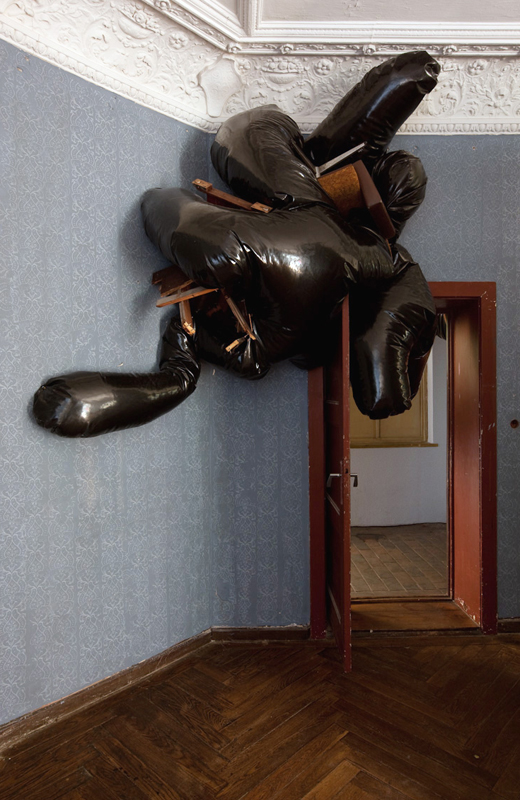Days before the Berlin Wall is torn down, Germans gather at it, 1989. Photographer unknown.
Tuesday night, former U.S. Ambassador Richard Barkley called East Berlin a “profoundly boring place,” drab and depressing compared to other places he’d been. His callous observation loosely framed a panel discussion at UCLA’s Hammer Museum, in which Barkley, German diplomat Michael Ott, and dramaturge Uta Schorlemmer remembered the fall of the Berlin Wall. All three of them had lived in Berlin (Ott in the West, Barkley and Schorlemmer in the East), and all three had felt the exuberance that swelled in the autumn of 1989.
To commemorate the 20th anniversary of the Berlin Wall’s fall, the Wende Museum has arranged to rebuild the wall in Los Angeles. Called “The Wall Across Wilshire,” the new structure loosely separates East and West L.A., though it’s too far from the city’s actual cultural battle lines to make anything more than a symbolic statement. It goes up in the evening of November 8 and ceremonially falls at midnight on November 9 (with such quick turnaround, the obstruction of Wilshire, a Los Angeles thoroughfare, won’t cause much frustration). A second structure, “The Wall Along Wilshire,” which includes a Border Tower from the original Berlin Wall, will run alongside the street from October 17 – November 14.
The Wende Museum organized Tuesday’s panel at the Hammer as a nuanced, interactive introduction to the Berlin Wall’s history. And what the three panelists told us, albeit indirectly, was indeed nuanced: they fleshed out a legacy more visual than political, a story full of unresolved colors and symbols.

Thierry Noir, Berlin Wall Mural, 1980s. Courtesy the Artist.
When Barkley called East Berlin “boring,” he meant that it lacked color, both literally and figuratively. As an outsider and a Westerner, he saw culture as synonymous with expression and activity, both of which were noticeably absent on the surface of the city. He didn’t sense monotony’s end until “the iconic pictures” by renegades like Thierry Noir and Christophe Bouchet, artists who would fugitively block in bright, tall profiles of flat-faced cartoon characters before making their getaway, began appearing on the wall’s façade.
Uta Shorlemmer, daughter of political radical Friedrich Schorlemmer, never really saw East Germany as monochromatic, but she did hear again and again that the grass was actually, physically greener as soon as you crossed the border, a claim she dismissed. Unlike some of her peers, she wasn’t interested in watching Dallas on television and having endless access to bananas (a notoriously romanticized commodity in East Berlin). She refused to equate freedom with ripe yellows and crisp greens. In fact, when the Wall fell, her first reaction was to stay home and wait for the right kind of revolution, one that wasn’t about getting into the West.
Michael Ott had reservations about the symbols of liberation too. A law student in 1989, he was studying next to his small TV when he heard the border had opened. He disbelievingly wandered out toward the nearest crossing where he saw West Berliners passing out bananas to incoming cars. “Knowing this banana fixation, I found it degrading,” he said. Even at a time of lighthearted elation, equating freedom with tropical fruit seemed too trite.

Mark Bradford, "Giant," 2007. Mixed media collage on canvas. Courtesy Sikkema Jenkins Gallery.
This battle between color as freedom and color as frivolity has concerned artists for eras, and it’s a territory that both Berliners and Angelinos have complicated in recent years. The unselfconscious emotiveness that characterized German neo-expressionism and the fetishism for which Californians have become known has subsided to make room for more conflicted approaches to surface and color. L.A. artist Mark Bradford treats color as something that decays easily and comes undone once co-opted by larger systems. Walead Besthy’s photographs find their shape and color via engineered accidents, approximating a-symbolism as best they can. Berliner Dennis Fedderson’s cancerous sculptures grow in unadorned exhibition spaces and are made of industrial material. Their neutrality gives them a more sinister tambour than they would otherwise have.

Dennis Fedderson, "Ausstellungsansicht Rohkunstbau XVI," 2009. Polyvinyl chloride, foam, styrofoam, found objects. Photo: Roland Horn.
Ambassador Barkley returned to Berlin this past March and found it colored-in. “Everything has been spiffed up,” he said, “everything looks good.” But he also saw that the spiff glossed over still-present economic and political difficulties. Color and shine can be as misleading as they can be telling.
When I drove home from the Hammer last night, I took Santa Monica Boulevard through Westwood, Beverly Hills, West Hollywood, Hollywood, and into Koreatown, where I live. The colors changed dramatically. At first, they were vibrant, prominent, and sleekly commercial, displayed on street signs and billboards. Then they became older and duller, until most light and color came from inside buildings instead of outside. These transitions represent class distinctions more than anything else (a distinction that also separated East and West Germany), though I maintain that they also represent value systems. Some people don’t have a choice, but others choose to live in neighborhoods that aren’t saturated with commercial colors. While I’m endlessly glad I don’t have to go through a checkpoint each time I enter a new economic bracket, I’m also glad that visual cues tell me where I am and what matters to the people around me.




Pingback: What’s Cookin at the Art21 Blog: A Weekly Index | Art21 Blog
Pingback: Looking at Los Angeles: Westward Expansion | Art21 Blog